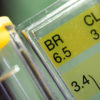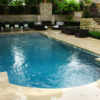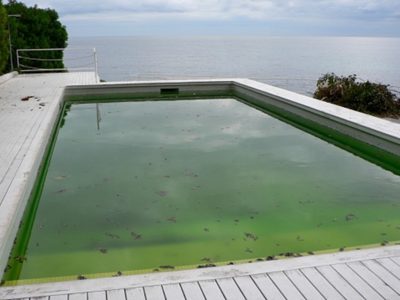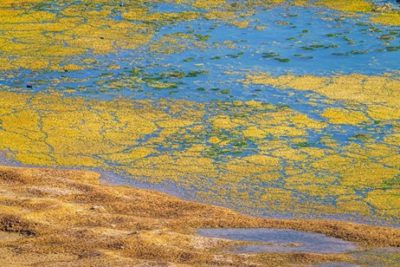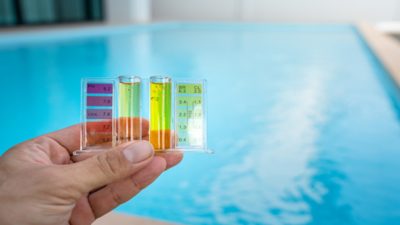Why Your Pool Went from Clean to Green Overnight?
You sleep one night, the next morning you wake up and see your pool green!!! How would you feel? Seeing swimming pool water from clean to green is one of the greatest shocks for the pool owners especially when they are already maintaining their pool regularly. You left your pool water sky blue and sparklingly beautiful and within a night it turns into a sluggish green. Yes, it happens and the major reason behind this is the presence of “Algae” and “bacteria” in the pool. The color of the pool water can be light green to deep green. If the shade of the pool is mild or lighter green, it means that it is just the start of an algae bloom and can be easily treated. However, if the water is in a darker shade of green then the problem is big as algae have bloomed. The cause for the overnight algae bloom is the outside warm weather because algae grow rapidly during warmer temperatures. Therefore, there could be several reasons that can be the source of causing algae growth.
The Green Monster (Algae)
Algae are the real monsters for turning your pool water from clean to green. Algae are microscopic and cannot be seen from the naked eye but when they bloom, we can see them as they turn your pool water green. The problem starts when the algae initiate to grow in your pool. The growth of algae occurs due to several reasons including organic matter, disturbances in the chemicals, pH imbalances, etc. Leaves, dirt, debris, dust, and other organic matter are the sources of algae growth. These organic matters enter easily into your pool through the wind. Not only these but the sunscreens used by the swimmers, their towels, swimsuits, and human sweat, all works as a booster for the growth of algae. “Algae” is the root cause for the discoloration of swimming pool water that grows due to the following reasons:
1. Inappropriate Levels of Sanitizers
The improper amount of sanitizer (chlorine or bromine) is one of the reasons for algae growth. You add chlorine or bromine into the pool for sanitizing and disinfecting the swimming pool water. If an insufficient amount of these sanitizers is added or the amount of free chlorine or free bromine in the pool becomes less, the algae start growing. The required amount of sanitizer in pool water is 2 ppm to 4 ppm. If its amount is less than 2 ppm then it will cause an algae bloom. These algae can stick onto the floor and walls of the pool or can float in water, thereby producing the green coloration of water. If we talk about chlorine, then not only its lower amount becomes the cause but also high levels of chlorine (more than 4 ppm) can turn the pool water into another shade of green color.
2. Disturbance in the pH Value
The pH value plays a vital role in the quality of swimming pool water. It tells whether the nature of the water is acidic or basic. The ideal value of pH required for swimming pool water is between 7.2 to 7.8. Whenever the value of pH disturbs, either it becomes less than the required amount or more, it causes the pool water color to be green. If the pH of pool water is less than 7.2 then it will cause erosion in plastic and metals which will change the watercolor. If the pH becomes above 7.8 then elemental scales will build-up, like calcium that change the nature of the water towards basic. This basic nature will not kill bacteria and they flourish to grow, resulting in the production of green coloration to the swimming pool water.
3. Insufficient Pumping and Filtration
If chlorine level in your pool is appropriate then the power and size of the filters and pumps can also become a reason for algae formation. If the size of pumps and filters is very small for your pool or does not run for enough time then it will not remove algae spores and bacteria completely. The incomplete removal of algae spores and bacteria will cause algae and bacteria build-up and growth. The problems regarding filters also depend on the type of filter you are using in your pool.
4. Oxidation of Copper
The oxidized copper can also become a cause for the changing of pool water color to green. When the oxidation of copper heaters occurs, the corroded copper is exposed to water. Though this is a rare condition, the direct contact of oxidized copper with pool water is a source of discoloration of water.
To solve this problem by yourself, you can use chelating agents to remove the copper from the swimming pool water or you can call a pool specialist so they can perform the required treatment.
5. High Levels of phosphates
Some people love to keep a garden that surrounds their pool area. You give fertilizers to the plants and flowers of your garden. The fertilizers are phosphates and they can easily enter the swimming pool. Another source of phosphate in the pool could be bird droppings and other minerals like rock, soil, etc. There are three forms of phosphate, which include: polyphosphate, metaphosphate, and orthophosphate. The presence of these phosphates in a high amount can be a reason for causing algae growth. To prevent algae growth the amount of phosphate in the pool should not exceed 500 ppb that is a very high value. Large amounts of phosphates are a good source of food for algae and are considered as their “buffet”. Algae eat the yummy food “phosphates” and grow rapidly turning your swimming pool color to green overnight.
What Should You Do When You Find Your Pool Green?
Whenever a pool owner finds his/her swimming pool water green, he/she wants to restore its beautiful sky-blue color from pea-green as soon as possible. For this, you have to check all the basic factors including the chemical, biological and physical impacts. Your pool needs special attention to keep it blue and clear with proper regular maintenance. Here are some remedies and actions that you need to take soon after you find your pool green.
1. Test the Pool Water
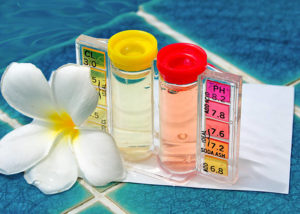
Firstly, you have to test the chemistry of your swimming pool water to know the real cause of green coloration. You have to test the value of sanitizer (chlorine or bromine) in the pool. If the value of chlorine is low or zero then you have to perform chlorine shock treatment. If the bromine level is low then perform the re-activation process. It is also important to test the alkalinity and pH values of water. You can use a liquid test kit or strips to test the alkalinity and pH values of the pool water. In case if your pool’s pH is high and you shock it with chlorine by thinking that it is due to chlorine deficiency, then this will make your pool very cloudy. The required pH value for swimming pool water is between 7.2 to 7.8. The alkalinity should be between 80 ppm to 120 ppm in the pool.
2. Shock Your Pool

To get rid of the green color of pool water due to the low levels of sanitizer (chlorine), you have to perform the shock treatment. The shock treatment consists of multiple steps. Firstly, check for the pH value. The pH value should be in range. Then you have to decide either to use granules or liquid chlorine that further depends upon the type of filter you are using in your pool. The next thing you have to take care of is to take the right amount of chemicals according to your pool’s volume. The recommended amount of chemical is 1 to 2 pounds in 10,000 water gallons. When you add the shock mixture then run the filter for a minimum of 24 hours or increase the time according to the need. This continuous filtration will remove the algae, bacteria, and other germs and you get the blue water.
3. Perform Proper Filtration

After shocking the pool for as much time as needed, you have to perform the proper filtration. You have to continue the filtration until you achieve clear crystal water. It may take 24 hours or maybe five days. The proper filtration will remove all the dead algae and bacteria from your pool thereby eliminating the green coloration of the pool. During filtration, you have to backwash the filters according to their type. Moreover, you still may have some cloudiness left which will take a few days to distinguish.
4. Brush Your Pool

When performing the chemical treatments and the circulation, the majority of the greenness will be removed from your pool. But maybe some green areas and cloudiness will be left. To remove this, you have to do brushing along with filtration for some days. It is a good choice to use an algae brush for scrubbing rather than a regular brush that you mostly use. Algae are stuck into the walls and floor of the swimming pool so an algae brush is preferred as it is hard while the normal brushes are nylon brushes. You have to properly scrub the steps, floor, walls, and other surfaces of the swimming pool
5. Use Algaecide
As discussed, the major cause for the green color of your swimming pool water is algae which are mostly green in color. Sometimes algae also occur in black color and mustard or yellow color. You can use an algaecide to treat your pool for removing the algae growth as it also prevents any future growth. Therefore, it is a good practice to use it during regular maintenance.
Algaecide treatments consist of two types that include metallic-based algaecide and ammonia-based algaecide. Metallic-based algaecide consists of copper and silver but they can cause stains in the swimming pool. While ammonia-based algaecide is mostly used because it does not cause any stain and is cheaper than metallic algaecides. Ammonia-based algaecides are highly effective for removing green algae. To kill black algae, use metallic-based algaecide and ammonia-based algaecide simultaneously. It is necessary to use a minimum of 30 percent of concentrations of algaecide otherwise, it may not work properly to kill algae. Before doing any other step of maintenance, you should settle algaecide for 24 hours.
Use Algaecide with Shock Treatment
The more efficient way to kill algae is to use the shock treatment and algaecide simultaneously. To achieve better results, use them in the sequence, firstly algaecide and then shock.
After killing all the algae, remove them from your swimming pool by running the filters and pumps. If you are using filters then set your filters to waste. This process will make your pool water from green to clean. Afterward, do not forget to clean your filters to completely remove algae from them. Otherwise, it may become a cause of algae regrowth.
6. Maintain Your Pool Regularly
At the end, when your pool is free from the annoying green color, test and balance your pool water again. To ensure the clarity of the water, also test the levels of sanitizers along with the alkalinity and pH of your pool. Regular testing and maintenance are necessary to keep the water clean and algae-free. For your ease, you can use smart monitors for measuring the pH values as they can monitor for 24 hours and inform you whether to add chemicals or not. If the level of sanitizer is low, immediately add them before the algae start to grow. Moreover, to avoid the buildup, wipe your pool’s tile line once a week. Empty skimmer baskets of your pool regularly. At last, clean your filters regularly as per their requirement.
Sum-up
The easiest way to keep your pool algae-free is to maintain it properly by regular monitoring. If you are aiming to throw a pool party in your backyard then test and balance the water before. Also, shock your pool when the guests leave the party because the sunscreen and human sweat could be a reason for algae growth. You can do several remedies, discussed in this article that can help in preventing algae growth.


